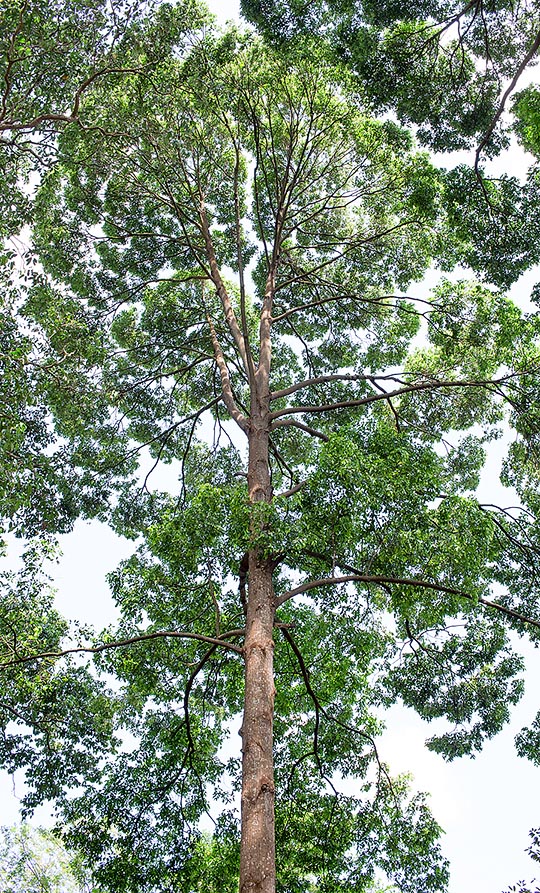Family : Dipterocarpaceae

Text © Pietro Puccio

English translation by Mario Beltramini

Native to tropical East Asia, Hopea odorata is an evergreen reaching the 45 m of height. Fine wood, waterproofing resin for varnishes and possible medicinal virtues © Giuseppe Mazza
The genus is honoured to the Scottish botanist John Hope (1725-1786); the specific name is the Latin adjective “odoratus, a, um” = odorous, perfumed, with reference to the fragrant flowers.
Common names : white thingan (English); telsur, tersol (Bangladesh); koki, mosau (Cambodia); kh’e:n (Laos); chengal mas, chengal pasir, thingan, sauchi (Malaysia); thingan (Myanmar); takhian thong, takhian-yai (Thailand); sao den, sao nghệ (Vietnam).
The Hopea odorata Roxb. (1811) is an evergreen resinous tree, 25-45 m tall, with cylindrical erect trunk, of up to more than 1 m of diameter, provided at the base with tabular roots (flattened roots similar to buttresses), with brownish bark deeply fissured longitudinally and young branches basically drooping. The leaves, on a 1-2 cm long petiole, are simple, alternate, oblong-ovate with entire margin and long pointed apex, 5-14 cm long and 3-6 cm broad, coriaceous, of glossy dark green colour. Terminal panicle inflorescences and at the axil of the upper leaves, villous, 12-15 cm long, bearing numerous tiny flowers of pale yellow colour pleasantly scented. Calyx with 5 ovate unequal lobes, villous, persistent, the two bigger ones grow with the ripening of the fruit forming two oblong membranaceous wings 5-6 cm long and 1-2 cm broad. Campanulate corolla, of 0,8-1 cm of diameter, with five oblong twisted lobes with fringed margin, 15 anthers and ovoid ovary. The fruit, enclosed in the winged persistent calyx, that favours its dispersion through the wind, is an ovate capsule with pointed apex, of about 1 cm of diameter, containing only one seed.
It propagates by seed, that must be planted in the shortest possible time having a short-lasting germinability, utilizing a draining organic loam maintained humid at the temperature of 25-28 °C, with germination times of 10-30 days; it reproduces also by cutting in summer.
Species of remarkable economic importance due to the excellent quality of the wood and the resin it gives, cultivable in the tropical and subtropical climate regions, not bearing temperatures close to 0 °C, if not exceptional and very short-lasting. It requires full sun except during the first years of life when it bears a partial shading, and adapts to various types of soil, preferably rich and deep. It is utilized also in the reforestation of degraded areas and as ornamental in parks and gardens and as road tree, keeping in mind in its collocation the size it may reach.
The wood, commercially known as “merawan”, fine-grained, of pale yellow colour that becomes pale brown if exposed to the light, hard, heavy, resistant to the atmospheric agents and to the termites, lasting, easy to work and refine, is utilized in the construction of dwellings, of boats, bridges, railway sleepers, furniture, and handicraft objects and artistic. The tree furnishes a transparent resin known as “rock dammar”, of good quality, utilized for varnishes and for waterproofing the boats.
Parts of the plant are utilized in the traditional medicine for various pathologies, but at the moment (2016) do not exist extensive studies about its efficacy and toxicity.
In some areas, due to the excessive exploitation and the habitat destruction, its presence has remarkably reduced, so much to be inserted into the red List of the IUN (International Union for Conservation of Nature) as “Vulnerable” (species at risk of extinction in the wild).
Synonyms: Hopea vasta Wall. (1829); Neisandra indica Raf. (1838); Hopea decandra Buch.-Ham. ex Wight (1840); Hopea wightiana Miq. ex Dyer (1874).
→ To appreciate the biodiversity within the DIPTEROCARPACEAE family please click here.
